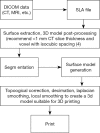Surgical applications of three-dimensional printing: a review of the current literature & how to get started
- PMID: 28090512
- PMCID: PMC5220021
- DOI: 10.21037/atm.2016.12.18
Surgical applications of three-dimensional printing: a review of the current literature & how to get started
Abstract
Three dimensional (3D) printing involves a number of additive manufacturing techniques that are used to build structures from the ground up. This technology has been adapted to a wide range of surgical applications at an impressive rate. It has been used to print patient-specific anatomic models, implants, prosthetics, external fixators, splints, surgical instrumentation, and surgical cutting guides. The profound utility of this technology in surgery explains the exponential growth. It is important to learn how 3D printing has been used in surgery and how to potentially apply this technology. PubMed was searched for studies that addressed the clinical application of 3D printing in all surgical fields, yielding 442 results. Data was manually extracted from the 168 included studies. We found an exponential increase in studies addressing surgical applications for 3D printing since 2011, with the largest growth in craniofacial, oromaxillofacial, and cardiothoracic specialties. The pertinent considerations for getting started with 3D printing were identified and are discussed, including, software, printing techniques, printing materials, sterilization of printing materials, and cost and time requirements. Also, the diverse and increasing applications of 3D printing were recorded and are discussed. There is large array of potential applications for 3D printing. Decreasing cost and increasing ease of use are making this technology more available. Incorporating 3D printing into a surgical practice can be a rewarding process that yields impressive results.
Keywords: Three-dimensional printing; computer-aided design; review; surgery; surgical specialties.
Conflict of interest statement
The authors have no conflicts of interest to declare.
Figures







References
Publication types
Grants and funding
LinkOut - more resources
Full Text Sources
Other Literature Sources
Medical
